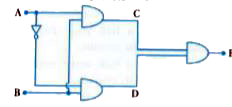Let A(1, 2, -3) and B(-1, -2, 1) are two vectors. Direction cosines of the vector joining the vector in the direction A to is ……………….Solution in Gujrati
There would be no interference pattern on the second screen but it would be lighted.
The second screen would be totally dark.
There would be a single bright point on the second screen.
There would be a regular two slit pattern on the second screen.
The correct Answer is:D
There would be a regular two slit pattern on the second screen.
Point P2 shown in figure (where there is a hole) is a point on the wavefront and so it behaves like a secondary source and so it emits light waves which are incident on slits S3 and S4. Here these two slits are illuminated at the same time by same wavefront. Hence they behave like coherent sources and so they produce stationary interference on the second screen kept behind them like YDSE (Young.s Double Slit Experiment).
Topper's Solved these Questions
- WAVE OPTICSBOOK - KUMAR PRAKASHANCHAPTER - WAVE OPTICSEXERCISE - SECTION-C NCERT Exemplar Solution (Multiple Choice Questions (More than One Options) )
4 Videos
- WAVE OPTICSBOOK - KUMAR PRAKASHANCHAPTER - WAVE OPTICSEXERCISE - SECTION-C NCERT Exemplar Solution (Very Short Answer Type Questions)
6 Videos
- WAVE OPTICSBOOK - KUMAR PRAKASHANCHAPTER - WAVE OPTICSEXERCISE - SECTION-B QUESTIONS-ANSWERS (Numerical From DARPAN. Based on textbook)
12 Videos
- SEMICONDUCTOR ELECTRONICS : MATERIALS, DEVICES AND SIMPLE CIRCUITS BOOK - KUMAR PRAKASHANCHAPTER - SEMICONDUCTOR ELECTRONICS : MATERIALS, DEVICES AND SIMPLE CIRCUITS EXERCISE - Section-D : Multiple Choice Questions (MCQs) (MCQs asked in Competitive Exams)
129 Videos
Similar Questions

Truth table for the given circuit (See figure) is
View SolutionIs Huygen's principle valid for longitudunal sound waves ?
View SolutionDiscuss the pattern of interference fringes obtained on the screen away from the two point sources.
View SolutionAt absolute zero temperature Si acts as ……..
View SolutionFind the direction cosines of the vector joining the points A(1,2,3)andB(1,2,1), directed from A to B.
View SolutionFind the direction cosines of the vector joining the points A(1,2,−3)andB(−1,−2,1), directed from AandB.
View SolutionFind the direction cosines of the vector joining the points A(1,2,−3)andB(−1,−2,1) directed from A to B.
View Solutionबिंदुओं A(-3,2,1) एवं B(1,-2,-1) को मिलाने वाले AएवंB से के अनुदिश दिष्ट सदिश के दिक् - कोसाइन ज्ञात कीजिए।
View SolutionFind the direction cosines of the vector joining the points A(1, 2,3) and B(-1, -2, 1) directed from A to B.
View SolutionFind the direction cosines of the vector joining the points A(-1, 2, 3) and B(1, 4, 1), directed from A to B.
View Solutionகொடுக்கப்பட்ட திசை விகி்தங்களைக் கொண்ட ஒரு வெக்டாின் திசைக் கொசைன்களைக் காண்க. 1, 2, 3
View SolutionIf the two directional cosines of a vectors are 1√2 and 1√3 then the value of third directional cosine is
View SolutionFind the direction cosines of the vector joining the points A(1,2,3)andB(1,2,1), directed from A to B.
View SolutionFind the direction cosines of the vector joining the points A(1,2,−3)andB(−1,−2,1) directed from A to B.
View SolutionIf the two directional cosines of a vectors are (1)/(sqrt(2)) and (1)/(sqrt(3)) then the value of thirs directional cosine is
View SolutionFind the direction cosines of the vector joining the points A(1,2,-3) and B(-1,-2,1), directed from A to B.
View Solution

